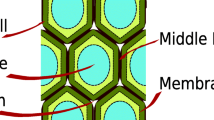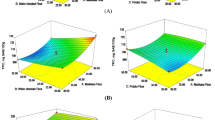Abstract
Twelve sweet and sour cherry cultivars were grown at the location 10°27′ (E) and 55°18′ (N) for the purpose of describing the morphological, physical and chemical properties of samples picked from their first day of maturity and 1, 4, 7, 11 and 18 days later. Acidity, soluble solids, redness (a) and lightness (L) increased significantly and linearly with the picking time, whereas yellowness decreased significantly and linearly with the picking time. Berry weight and the level of anthocyanin increased significantly according to positive multiplicative equations, while stone percentage and cyanide content decreased according to negative multiplicative equations during the picking period. Factor analysis revealed a linear and positive relationship between factor scores and maturity days, which may be used for determination of fruit development and picking time. In addition, the factor analysis made it possible to divide the quality characteristics of cherries into five groups or factors: factor one being the number of days and yellowness, factor two being berry weight and stone percentage, factor three being the level of benzaldehyde and number of maturity days, factor four being the level of anthocyanin and content of soluble solids and factor five being the acidity and anthocyanin levels.
Similar content being viewed by others
References
Westwood MN (1993) Temperate zone pomology-physiology and culture, 3rd edn. Timber Press, Portland
Faust M (1989) Physiology of temperate zone fruit trees. Wiley, New York
Guimond M, Andrews PK, Lang GA (1998) Scanning electronic microscopy of floral initiation in sweet cherry. J Am Soc Hortic Sci 124:509–512
Eng H, Ünal A (2007) Examination of flower bud initiation and differentiation in sweet cherry and peach by scanning electron microscope. Turk J Agric For 31:373–379
Serrano M, Guillen F, Martinez-Romero D, Castillo S, Valero D (2005) Chemical constituents and antioxidant activity of sweet cherry at different ripening stages. J Agric Food Chem 53:2741–2745
Gonçalves B, Silva AP, Outinho-peria JM, Bacelar E, Rosa E, Meyer AS (2007) Effect of ripeness and postharvest storage on the evolution of colour and anthocyanins in cherries (Prunus avium L.). Food Chem 103:976–984
Mozetic B, Simc M, Trebs P (1997) Anthocyanins and hydroxycinnamic acids of Lambert Compact cherries (Prunus avium L.) after cold storage and 1-methylcyclopropene treatmen. Food Chem 97:302–309
Sun SY, Jiang WG, Zhao YP (2009) Characterization of the aroma-active compounds in five sweet cherry cultivars grown in Yantai (China). Flavour Fragr J 25:206–213
Predieri S, Dris R, Sekse L, Rapparini F (2003) Influence of environmental factors and orchard management on yield and quality of sweet cherry. J Food Agric Environ 1:263–266
Girard B, Kopp TG (1998) Physiochemical characteristics of selected sweet cherry cultivars. J Agric Food Chem 46:471–476
Usenik V, Fajt N, Mikulic-Petkovsek M, Slatnar A, Stampar F, Veberic R (2010) Sweet cherry pomological and biochemical characteristics influenzed by rootstock. J Agric Food Chem 58:4928–4933
Damar I, Ekşi A (2012) Antioxidant capacity and anthocyanin profile of sour cherry (Prunus cerasus L.) juice. J Agric Food Chem 135:2910–2914
Khorshidi S, Davarynejad G, Tehranifar A, Fallahi E (2011) Effect of modified atmosphere packaging on chemical composition, antioxidant capacity, anthocyanin, and total phenolic content of cherry fruits. Hortic Environ Biotechnol 52:471–481
Serradilla MJ, Martin A, Hernandez A, Lopez-Corrales M, Cordoba de Guia L (2010) Effect of commercial ripening stage and postharvest storage on microbial and aroma changes of ‘Ambrunesʼ sweet cherries. J Agric Food Chem 58:9157–9163
Wen Y-Q, He F, Zhu B-Q, Lan Y-B, Pan Q-H, Li C-Y, Reeves MJ, Wang J (2014) Free and glucosidically bound aroma compounds in cherry (Prunus avium L.). Food Chem 152:29–36
Forni E, Polesello F, Torreggiani D (1993) Changes in anthocyanins in cherries (Prunus avium) during osmohehydration, pasteurization and storage. Food Chem 48:295–299
Gao L, Mazza G (1995) Characterization, quantitation, and distribution of anthocyanins and colourless phenolics in sweet cherries. J Agric Food Chem 43(2):343–346
Schmid W, Grosch W (1986) Quantitavive analyse flüchtiger aromastoffe mit hohen aroma werten in sauerkirschen (Prunus cerasus L.). Z Lebensm Unters Forsch 183:39–44
Roversi A, Ughini V (1996) Influence of weather conditions of the flowering period on sweet cherry fruit set. Acta Hort 410:427–433
Shahbazi F, Rahmati S (2013) Mass modeling of sweet cherry (Prunus avium L.) fruit with some physical characteristics. Food Nutr Sci 4:1–5
Nordey T (2014) Model-assisted analysis of spatial and temporal variations in fruit temperature and transpiration highlighting the role of fruit development. PLoS ONE 9:1–12
Poll L, Petersen MB (2003) Influence of harvest year and harvest time on soluble solids, titratable acids, anthocyanin content and aroma compounds in sour cherry. Eur Food Res Technol 6:212–216
Chaovanalikit A, Wrolstad RE (2004) Total anthocyanins and total phenolis of fresh and processed cherries and their antioxidant properties. J Food Sci 69:67–72
Chaovanalikit A, Wrolstad RE (2004) Anthocyanin and polyphenolic composition of fresh and processed cherries. J Food Sci 69:73–83
Batisse C, Fils-Lyacon B, Buret M (1994) Pectin changes in ripening cherry fruit. J Food Sci 59:389–393
McLellan MR, Cash JN (1979) Application of anthocyanins as colorants for marasckca bio cherries. J Food Sci 44:483–587
Bandion F, Valenta M, Kain W (1976) Contribution to an evaluation of benzaldehyde contents in stone fruit fine brandies and stone fruit liquors. Mitt Rebe Wein Obstb Früchteverwent Klosterneuburg 26:131–138
Stinson EE, Dooley CJ, Filipic VJ, Hills CH (1969) Composition of montmorency cherry essence. 1. Low boiling components. J Food Sci 34:246–248
Stinson EE, Dooley CJ, Filipic VJ, Hills CH (1969) Composition of montmorency cherry essence. 2. High boiling components. J Food Sci 34:544–546
Author information
Authors and Affiliations
Corresponding author
Ethics declarations
Conflict of interest
None.
Compliance with ethics requirements
This article does not contain any studies with human or animal subjects.
Rights and permissions
About this article
Cite this article
Kaack, K. Maturation and picking time for sweet cherries (Prunus avium) and sour cherries (Prunus cerasus L.). Eur Food Res Technol 243, 539–546 (2017). https://doi.org/10.1007/s00217-016-2753-6
Received:
Accepted:
Published:
Issue Date:
DOI: https://doi.org/10.1007/s00217-016-2753-6




